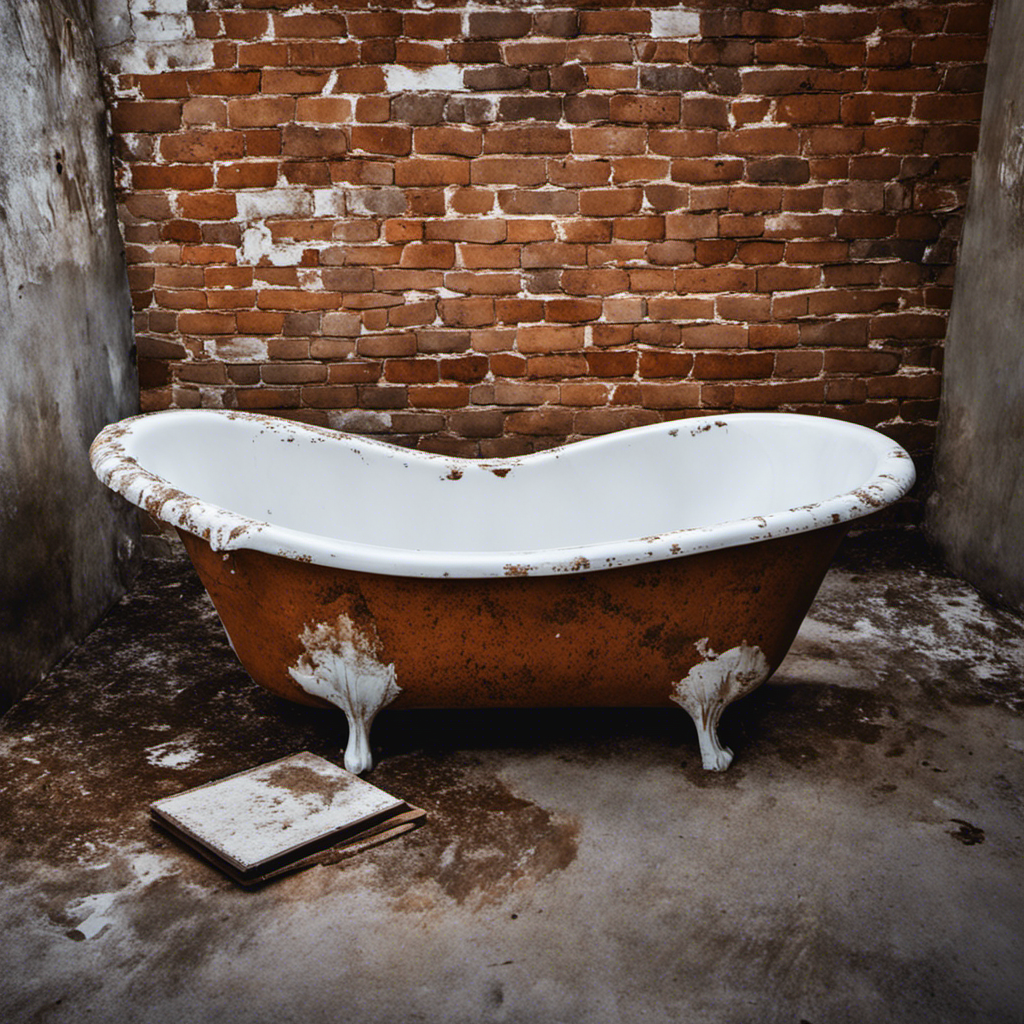Do you ever wonder just how much your full bathtub weighs? It’s not something you think about every day, but understanding the weight of your bathtub can be important for a variety of reasons.
From installation considerations to ensuring the structural integrity of your floor, knowing the weight of a full bathtub is essential.
In this article, we will explore the factors that affect bathtub weight, the average weight of different materials, and how to calculate the weight of a full bathtub.
So, let’s dive in and discover the weighty world of bathtubs.
Key Takeaways
- Bathtub weight distribution is not evenly distributed throughout its structure.
- The weight of a bathtub is influenced by the material it is made of, with cast iron bathtubs being the heaviest.
- The amount of water in the bathtub adds to its total weight, with larger bathtubs holding more water.
- Proper planning, understanding of weight distribution, and securing the bathtub are important for safe installation.
Factors Affecting Bathtub Weight
When determining the weight of a full bathtub, there are several factors that can affect it. One of the key factors is the bathtub weight distribution. The weight of the bathtub is not evenly distributed throughout its structure.
The majority of the weight is concentrated on the bottom and sides of the bathtub, where the water is held. This weight distribution can impact the installation process. When installing a bathtub, it is important to consider the weight distribution to ensure proper support and stability.
The weight of the bathtub, especially when filled with water, can put strain on the floor and surrounding walls. Therefore, it is crucial to have a solid and sturdy foundation to support the weight and prevent any potential damage or accidents.
Average Weight of Different Bathtub Materials
The average weight of various bathtub materials can vary significantly, impacting the installation costs and bathtub weight distribution. Here is a breakdown of the average weight for different bathtub materials:
- Acrylic: A lightweight material, acrylic bathtubs typically weigh between 60-100 pounds.
- Fiberglass: Similar to acrylic, fiberglass bathtubs weigh around 60-100 pounds.
- Cast Iron: Known for its durability, cast iron bathtubs are quite heavy, weighing between 300-500 pounds.
- Steel: Steel bathtubs fall in the middle range, weighing approximately 150-250 pounds.
- Composite: Composite bathtubs, made from a mix of materials, can weigh between 100-200 pounds.
Understanding the average weight of different bathtub materials is essential for installation purposes and calculating the impact on the overall weight distribution.
Now, let’s explore how water adds to the total weight of a bathtub.
How Water Adds to the Total Weight of a Bathtub
To calculate the total weight of your bathtub, you’ll need to consider how much water is added. Water displacement in bathtubs is an important factor in determining the weight. The larger the bathtub, the more water it can hold, and therefore, the greater the weight. Let’s take a look at the impact of bathtub size on water weight:
| Bathtub Size | Water Capacity |
|---|---|
| Small | 50 gallons |
| Medium | 75 gallons |
| Large | 100 gallons |
As you can see, the water capacity increases as the bathtub size increases. This means that a larger bathtub will have a higher total weight due to the added water. Now that you understand how water adds to the total weight, let’s move on to calculating the weight of a full bathtub.
Calculating the Weight of a Full Bathtub
If you want to determine the weight of your bathtub when it’s filled with water, you can follow a simple calculation.
First, you need to calculate the volume of water in the bathtub. This can be done by measuring the length, width, and depth of the bathtub and multiplying these dimensions together.
Next, you need to convert the volume of water into weight. The weight of water is approximately 8.34 pounds per gallon. Multiply the volume of water by this weight to get the total weight of the water in the bathtub.
Finally, consider the weight distribution. Remember that the weight of the water will be evenly distributed throughout the bathtub.
Keep in mind that this calculation only accounts for the weight of the water and does not include the weight of the bathtub itself or any other items in it.
Safety Considerations for Installing Heavy Bathtubs
When installing heavy bathtubs, it’s important to consider safety precautions.
Bathtub installation precautions should include proper planning and understanding of the weight distribution. Before installing the bathtub, ensure that the floor can support the weight of the tub and the water it will hold. It’s crucial to consult a professional if you’re unsure about the floor’s capacity.
Additionally, you should use proper lifting techniques and equipment to avoid strain or injury.
When positioning the bathtub, make sure it is securely fastened to prevent any movement or instability. Installing adjustable support legs can help distribute the weight evenly and provide additional stability.
Lastly, always follow the manufacturer’s guidelines and recommendations to ensure a safe and secure installation.
Frequently Asked Questions
Can I Install a Heavy Bathtub on a Second Floor or Upper Level of a House?
You can install a heavy bathtub on an upper level of a house, but it requires careful consideration and planning. Common mistakes during the installation process can lead to structural damage or safety hazards.
What Are the Potential Risks or Dangers Associated With Installing a Heavy Bathtub?
When installing a heavy bathtub on an upper level, potential risks and dangers arise. Structural damage, compromised stability, and increased risk of collapse are just a few of the concerns that should be considered.
Are There Any Specific Building Codes or Regulations That Need to Be Followed When Installing a Heavy Bathtub?
When installing a heavy bathtub, it is important to ensure building code compliance. This includes following regulations regarding weight distribution to prevent structural damage and ensure the safety of the installation.
Is It Possible to Reinforce the Floor or Foundation to Accommodate the Weight of a Heavy Bathtub?
To ensure your floor or foundation can support the weight of a heavy bathtub, reinforcing is possible. Evaluate the floor’s strength, consider adding support beams or columns, and consult with a structural engineer for precise recommendations.
Are There Any Special Precautions or Considerations to Keep in Mind When Moving or Transporting a Heavy Bathtub?
When moving a heavy bathtub, there are important precautions to consider. Ensure you have a sturdy dolly or cart to transport it safely. Protect the tub by wrapping it in blankets or using moving pads.
Conclusion
So, now you know how much a full bathtub weighs. The weight of a bathtub can vary depending on factors such as the material it is made of and the amount of water it holds.
On average, a standard acrylic bathtub can weigh around 150-200 pounds, while a cast iron bathtub can weigh up to 500 pounds. However, it’s important to note that water adds significant weight to the bathtub, with each gallon weighing around 8.3 pounds.
To calculate the weight of a full bathtub, simply multiply the volume of water by 8.3 and add it to the weight of the empty bathtub. When installing heavy bathtubs, it is crucial to consider safety measures to prevent accidents and ensure a secure installation.
Did you know that a full bathtub can weigh over 1,000 pounds when filled with water?










